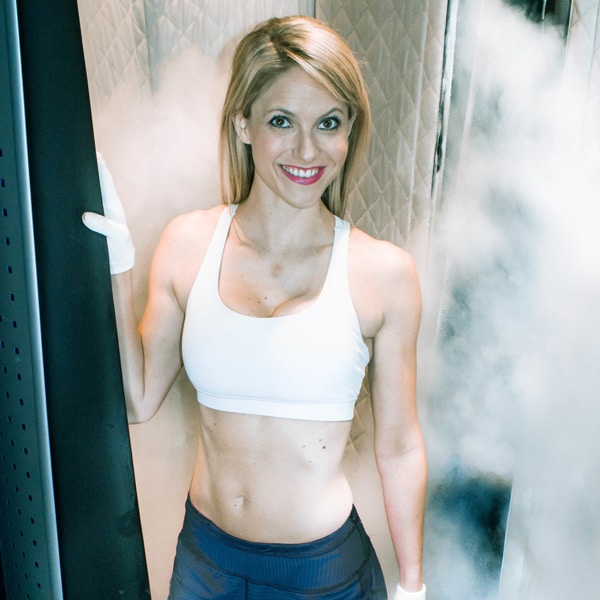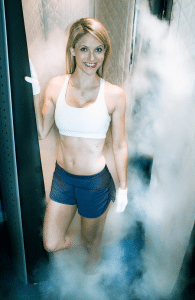
Cryotherapy: Freezing for Good Health
Cryotherapy expert Julie Shanebrook explains how three minutes in -260 degrees can lead to a healthier you
By Sarah Emily Gilbert
On September 9, millions of viewers watched as Michael Strahan from Live! with Kelly and Michael entered into a “Whole Body Cryotherapy” chamber provided by the Texas-based company, CryoUSA. Although the idea of cryotherapy – and the cryotherapy chamber – looked like things of the future, according to Kelly Ripa, Strahan, and thousands of cryotherapy diehards, it’s time is now.
There’s no better proof of this than the new cryotherapy spas popping up across the country like Red Bank, New Jersey’s Chill Cryotherapy. Opening its doors early next month at 327 South Avenue West (directly across from the South Avenue Train Station), Chill Cryotherapy will be bringing this European craze to north Jersey. So, what exactly is cryotherapy and why is it becoming the next big thing? Urban Agenda turned to owner and founder of Chill Cryotherapy, Julie Shanebrook, for more insight on this innovative health trend.
What made you decide to open a cryotherapy spa in Red Bank?
I became interested in whole body cryotherapy through my physician who was using it for his patients with chronic pain issues. I have always been athletic, and I have perpetual injuries, muscle soreness, pain, and inflammation. I’ve had plantar fasciitis, herniated discs, carpal tunnel syndrome….the list goes on. I felt that my sphere of activities was constantly shrinking because of pain and injuries. I desperately wanted to use whole body cryotherapy to alleviate pain and inflammation—but there were no cryotherapy centers nearby. I decided to bring it to Central New Jersey to share all of the benefits with my community here.
What exactly is cryotherapy, and why has it suddenly become so popular?
Cryotherapy is the brief application of extremely cold temperature to the skin…It is a very clever treatment in the sense that it works on the concept of “perceived hypothermia.” Your skin perceives the cold temperature in the cryosauna and communicates this to the brain. The brain triggers what is called the “fight or flight response” to this perceived danger (the extreme cold). The beauty of cryotherapy is that you are not in actual danger—there is no risk of hypothermia during a Chill Cryotherapy session because your core temperature does not drop and the sessions only last three minutes. But you will receive all of the benefits of your brain thinking that you are in danger without actually being in danger.
The “fight or flight” response in your body is meant to maximize your chances of survival in the face of a perceived threat. Therefore, the “fight or flight” process turns you in the very best version of you—both physically and mentally. It turns you into a super-human version of yourself so that you can either run away from the threat or defend yourself against it.
The fight or flight response during cryotherapy causes an immediate vasoconstriction—this means that your blood is rushed to your core—in an effort to maintain core temperature. While your blood is circulating in your core it becomes highly oxygenated and enriched with nutrients. After the treatment is over and you experience a rebound vasodilation, this “super blood” flows back to the rest of your body—reducing inflammation, pain and speeding up the healing process all over your body. Another benefit is that your blood circulation improves during this vasodilation throughout your entire body, including in your skin (makes you look amazing!).
A second element of the fight or flight process is that the brain triggers the release of anti-inflammatory and analgesic (pain relieving) enzymes and cytokines. This also makes a lot of sense because your brain wants you to be as mobile, flexible and pain free as possible in order to defend against the perceived threat. Your brain also releases endorphins and norepinephrine (reduces pain)—these have a cognitive and mental effect. You become extremely alert, aware and positive/optimistic.
The final element of the fight or flight response that we experience during cryotherapy is a boost in our metabolism—your brain recognizes that you need more energy to combat the perceived threat and therefore it raises your metabolism in order to generate more energy. This is why cryotherapy causes an increase in the metabolism.
Cryotherapy also burns a lot of calories — 500 to 800 calories from a three minute session. This calorie-burn occurs because the vasoconstriction requires a lot of energy as does the re-heating process in the body after the session is over.
What treatments do you offer at Chill Cryotherapy?
We use two kinds of cryotherapy at Chill Cryotherapy: whole body cryotherapy and local cryotherapy. We offer whole Body Cryotherapy in a cryotherapy machine called a cryosauna. This is a booth that the client stands in. We use liquid nitrogen to chill ambient air to -260 degrees fahrenheit. Sessions last a maximum of three minutes, but we can customize each session’s length and temperature to the client (although never allowing for a session to last longer than three minutes).
We use a local cryotherapy machine for local treatments. Liquid nitrogen chills ambient air to -260F and creates a vapor mist—we apply the mist with a long nozzle to specific areas of inflammation, pain and injury. We also give CryoFacials.
Do you have to come for multiple treatments in order for the therapy to be effective or can it be a one shot deal?
Research has shown that a series of 10 treatments yields the most effective results, those treatments need to be completed within a three and a half week period, so approximately three to four times for the first three weeks. Those results should last anywhere from three to six months. Once the initial 10 treatments are completed, clients can evaluate their progress—many decide to continue with intensive sessions while others drop down to a maintenance protocol. Clients with specific health conditions such as weight loss, autoimmune disorders, etc. may want to maintain an intensive session protocol until they achieve their goals. Athletes can tailor sessions to their events and workouts—many athletes routinely use cryotherapy two to three times a week and before and/or after events. Everything is customizable so individual clients needs are always addressed.

